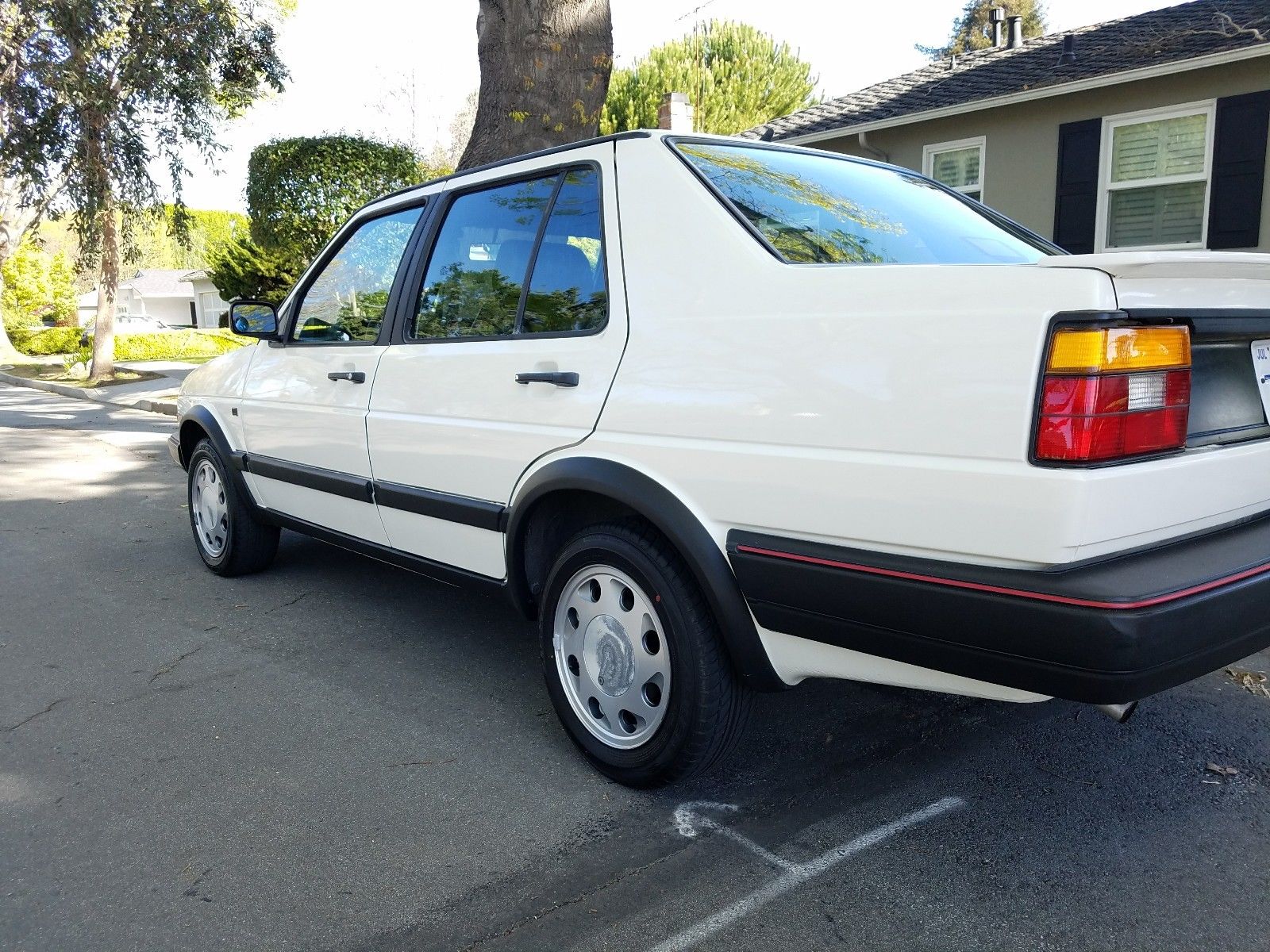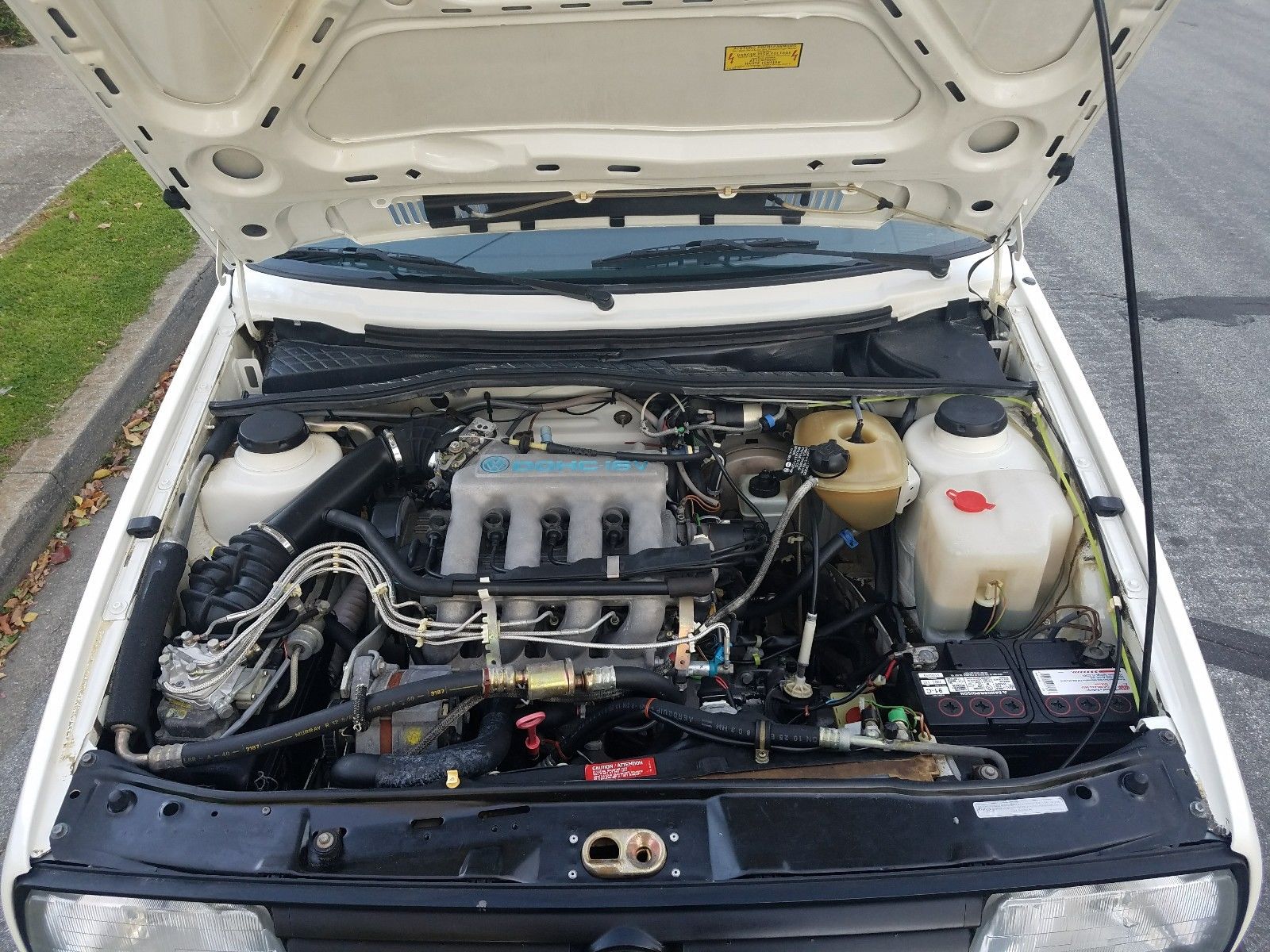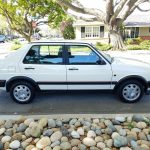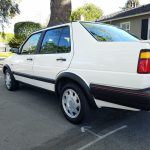The introduction of the DOHC motor into the Volkswagen lineup may not have heralded a massive increase in power; on paper, the 21 horsepower bump from the RD 8 valve 1.8 liter inline-4 to the PL 16V of the same displacement was pretty modest compared to the massive leaps of today. But in a 2,000 lbs car, the 20% bump in thrust meant that the new Jetta GLI 16V for 1987 felt like the rocket ship its tach acted like every time you stabbed the throttle. To match the additional power, Volkswagen offered many upgrades over the standard 8 valve GLI in 1987, the only year they were offered together in the U.S. market. A deeper front lip spoiler with brake ducting and rear spoiler added boy-racer looks. Though the wheels remained 14″x6″, the new “Silverstone” design you know as “Teardrops” looked cooler than the bottle-cap inspired design on the 8V. A swept-back Fuba roof-mounted antenna continued the speed theme and became the signature Volkswagen look for some time. Inside 16V badges on the dash and a higher red line prepared you for the thrill ride while heavily bolstered half-cloth, half-leatherette Recaro Trophy seats hugged you. And to show how fancy you were to your friends, this Volkswagen included a lit key fob – the first I can think of for a Volkswagen. The Jettas were also marketed upscale of the more boy-racer GTI (a trend which recently has been reversed), so options included power windows, air conditioning and a sunroof, and the model carried over from 1987 largely unchanged into 1988. They were a cut-rate M3 to an entire generation that was never able to even contemplate new BMW ownership, and became wildly popular as a result:
CLICK FOR DETAILS: 1988 Volkswagen Jetta GLI 16V on eBay
Year: 1988
Model: Jetta GLI 16V
Engine: 1.8 liter inline-4
Transmission: 5-speed manual
Mileage: 46,000 mi
Price: No Reserve Auction
up for auction is this beautiful 1988 jetta gli 16v.5speed and ac. it has 46k original miles and has been garaged and very well cared for. its in amazing condition both in and out. original paint shine as new. its 100% stock and original and never modified. was bought new in Germany by original owner and have all original document booklets and shipping papers. car runs great and everything is in working order as expected. a $500 non refundable deposit is required 2 day after auction end I also reserve the rite to end this auction early. bid to win!
Saying that you don’t often find a clean GLI is an understatement. Saying you found an all original clean one is cause for celebration. Add sub-50,000 miles on the odometer to that description and you better play the lottery. Okay, it’s not 100% stock – one look a the Kenwood stereo in the dash would tell you otherwise, but impressively original is the best description I can think of. I don’t recall ever seeing an original paint early A2 without a fully salt-and-pepper front end, but the lower valance on this car seems virtually untouched by debris. While a respray would easily cover up that age, the lower mileage is backed up by the unbelievable under-hood shot, which looks like the car could be in for a second-year service rather than 30 years down the road. Inside there are no gripes either, with an almost flawless interior depicted. There are two minor repairs that could easily take this to the next step; somewhat inexcusable for a car at this level is the missing secondary antenna, a $15 part easily sourced. More understandable and harder to correct are the delaminated centercaps. But those are small faults on what otherwise is one of the best condition, most original ’88s I’ve seen in a bit. The earlier playing the lottery analogy comes back at this point; with a day remaining, bidding is nearly $8,000. That was a number unthinkable only a few years ago, but this has become the new norm on stellar survivors from the 1980s. In fact, compared to the prices some of the competition are fetching these days, one might even say it’s a bit of a bargain for what is a near irreplaceable bit of performance Volkswagen sedan.
-Carter











I’m wondering something. Purchased in Germany I’d love to know if it is a Euro market car or US market car. The Euro Fuel inj, intake manifold, and intake cam really wake these up.
@greggiekay;
I think it’s a U.S. car. It’s got U.S. spec headlights, a U.S. spec gauge cluster, and U.S. spec bumpers. I suppose those could have been changed out, but the tub surround area would be a clue as they’re different too – though I don’t see any images of that. However, the VIN is an indication it’s probably a US car too – German models were WVWZZZ….
http://i.ebayimg.com/00/s/MTYwMFgxMjAw/z/qsgAAOSwa~BYXopI/$_20.jpg
Man, this would’ve been unobtanium in high school when new, unless one was an inexplicably 28 year old James Spader in some teen movie.
It’s a US-market car. The fenders wear the US-market “banana” lights, and have plugs where the EU-market turn signal repeater lamps would reside. It does have the correct plug on the left fender for the antenna hole. Fuba antenna mast is missing from the roof.
Also, the front bumper tow hooks are part of the bumper brackets. The euro-spec cars had tow hooks that were body-color and welded to the frame, front & rear. If you’ve ever had the bumpers off of a later Mk2 “Big Bumper” car, and seen the tow hooks – that’s what the euro-market cars have for tow hooks.
That said, the bumpers are correct for a German-built car, with front turn signal lenses that screw in from the front of the bumper. The US-built Mk2s had turn signal lenses attached from the rear of the bumper.
This is an early 1988 model, as evidenced by the early instrument cluster with the upshift light, and fuel/temperature gauges at the bottom of the tach. Later 1988 models had the coolant temp gauge in place of the shift light, and the fuel gauge using the bottom center of the tach.
Rear muffler has been replaced with an 8V unit. The 16v cars have a dual-exit rear muffler without downturned tailpipe.
Conspicuous for it’s absence is a clear picture of the driver’s seat outer bolster, which is a high-wear area on these cars.
Otherwise, this is a very nice example, and would take very little to be a factory-correct museum piece.
@Dave – agreed and good commentary. However, the German early Jettas I’ve seen have a different front bumper with plate cutout. Here’s an example: http://i.ebayimg.com/images/g/1XMAAOSwLVZVtN2b/s-l1600.jpg
Thanks for the info
Very nice car!
Oddly enough I don’t mind the “small” bumpers on the GTI 16V’s, maybe it’s the black paint under the bumpers? But on the Jetta’s I really, really, really prefer the big bumper/bbs/velour seated versions.
I had a black ’91. One of my favorite cars of all time, but I could never get it to stop rattling. So many rattles.
The rattles were a good sign, it meant the piece in question was hanging on for dear life. Major build quality, this. To avoid the rattley-ness you had to pony up for an Audi 80/90. No rattles, just dead silence … eerie, broken, dead silence.
@Carter – The US-market car in the picture you posted(an early 1990 model – big bumpers were added mid-model year) has a European-market front bumper on it, evidenced by the plate recess & Mk1 Golf-style turn signals with 2 screws. The plate recess was not present on the US-market cars, as they had a larger(and heavier) front bumper reinforcement behind the plastic cover.
@Dave, the picture I posted is a Jetta for sale in Germany. It’s not a U.S. spec car, and it is listed as a 1988. Period German marketing for the Jetta has the same bumper. See:
http://www.ebay.de/itm/VW-Jetta-GL-Bauj-10-1988-/252808846544?hash=item3adc94dcd0:g:1XMAAOSwLVZVtN2b
@ Carter – You’re right, the silver car you posted is a German-built car for the Euro market. The GLI 16V for the US Market(like the white one in the ad) was built in Germany, but with US-market specifications, including larger US-spec bumpers.
@Dave – I think we’re speaking the same language but saying different things.
The white car (’88 GLI) is a U.S. market car which was produced in Germany. Your insight on the differences in the mounting points for the turn signals is interesting! I went back to look at pictures of my Westmoreland Golf, but I don’t have enough detail of the front to see the blinker mounts. I did note, however, that my Golf didn’t have Euro signal cover blanks behind the wheel.
I originally read your comment to say that the German market and US market bumpers were the same. That’s why I referenced the Euro plate cutout for the German ’88, which caused some confusion because you thought it was a U.S. spec ’90 model. I think we’re on the same page now!
I think all of the GTI/GLI 16V models were German produced, correct?
Thanks for the input, this small detail stuff is something I always find interesting.
@BRAD, In that case the my ’91 was of unsurpassed build quality.
In other news I went and test drove a Tornado ’91 GLI 16v for sale near me today and LOVED IT! It’s been a long time since I’ve driven one. It’s everything my b7 s4 isn’t (and I *love* my s4). I realize now that I’ve been like the proverbial frog in a slowing boiling pot. Since the Mk3/b5 cars arrived everything has become nicer, more refined, more powerful… and more isolating. I knew this at a mental level, but until today I had not realized it a visceral level. Oh how far away I’ve gotten from that raw driving experience.
I’m in need of a 3rd (wtf?!) car. I’ve been debating an e36/46 M3, e39 M5, 964, 993, 997, Mk6 GTI. But that’s all over now. I’m 100% on the hunt for a MKII 16V and regret that I didn’t bid on this ’88.
@Carter – Production of A2 Chassis VWs for the North American market was a little all over the place. The GLI 16V was produced exclusively in Germany throughout it’s production run(’87-92). The Golf, GTI, and GTI 16V were produced in Westmoreland, Pa from ’87-89, then Mexico from ’89-92. Other Jetta trim levels were produced in all three locations, but North America never got a German-produced Mk2 Golf in any form. Westmoreland produced cars(like yours) were the only Mk2s without the blanks in the rear of the fenders. Both German- and Mexican-built cars had them. Dashboards in the Westmoreland cars were different, as well(clip-in dash trim vs screwed-in bezel in the WVW & 3VW cars). There were a number of other production variances between locations, including things like wiring harnesses, parking brake mechanisms, and head/tail lamps. Ex: The 1985 Westmoreland-built Golf had unique headlamps and grille not found on any other Mk2 Golf or Jetta(also note the unique fenders and front turn signals): https://www.thesamba.com/vw/classifieds/pix/6698656.jpg
@Dave, yes, the ’85/86 Golfs were unique. They had different wheel trim, too, which mimicked the high-spec A1 cars but was slightly different. Mine was an ’86, which was the last year of that trim setup before it went to the 3-bar grill, 1 piece front window setup for the Digifant cars. The early A2 Westmoreland cars were neat because they were like a very nicely updated A1.
Mostly correct info but 3VW cars did not have side marker holes in the fenders and subsequent badges to cover them. 85- mid 86 golfs got westy fronts with 6 X 7″ sealed beams. Late 86 golfs got aeros. 3 bar grilles, 1 piece front windows and digi were 88 models although I have seen very late 87 Jettas with digi.